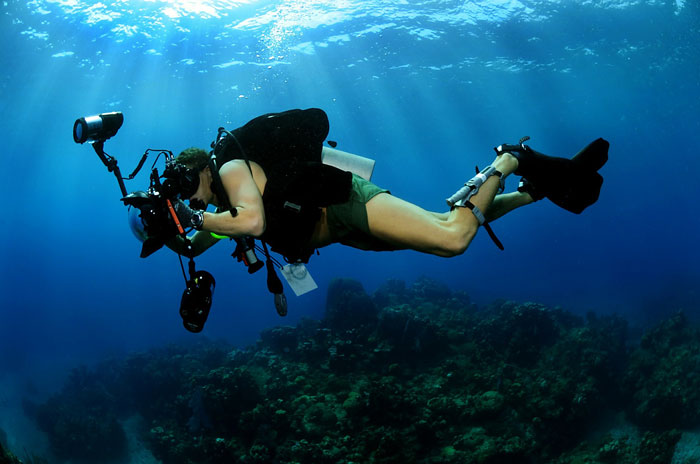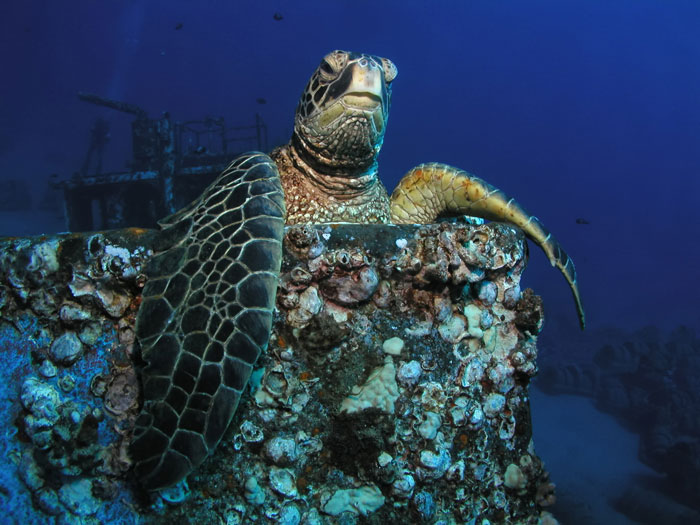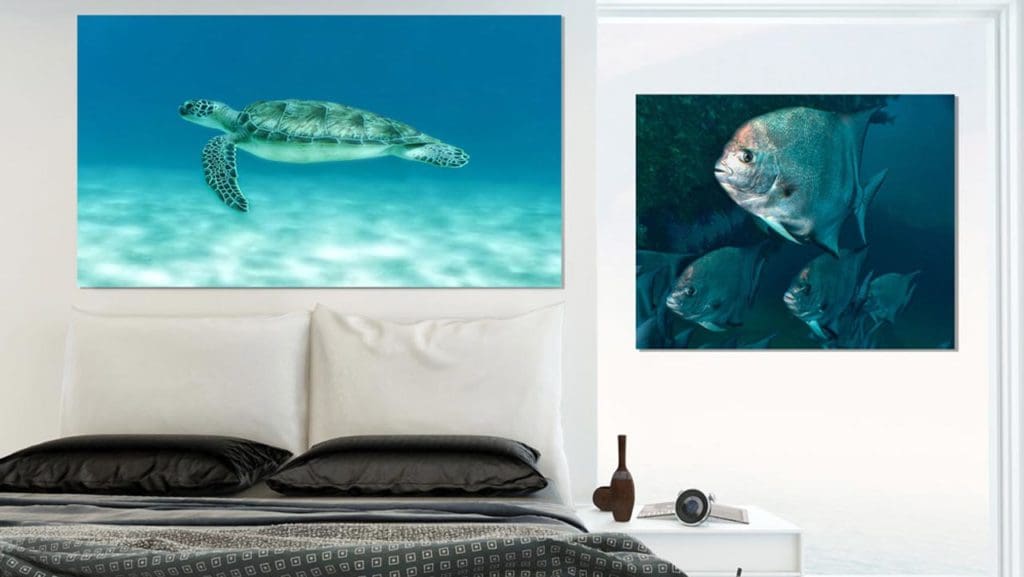Underwater Photography Tips for Printing Images on Canvas
Life under the sea is intriguing and refreshing to us land dwellers, and hopefully the underwater photography tips provided here will open a portal to life beneath the waves while providing some great ideas for preserving that beauty forever.
The underwater world is not something we see every day. Often the only glimpses we get into the deep are from those who dare to enter this uncharted territory in hopes of capturing their discoveries on camera. Everyone appreciates an up close interaction with marine life, but most don’t have the opportunity to dive in and see for themselves.
Fortunately, it is possible to bring this beautiful marine life into the home, without setting up an in-house aquarium! Through digital print reproduction you can print your favorite underwater photograph on canvas. The images printed on canvas are as clear and crisp as if you were looking directly into the deep through a real porthole.
But before you start printing on canvas, you need underwater shots worthy of wall art. To help you adventurous types create these gallery-quality images and prints, this article offers underwater photography tips that just may help you create ripples in the world of photography.
Work on Your Diving Skills
Learning the rudiments of diving and safety is crucial to underwater photography. When shooting subjects native to the underwater scene, you will need to enter their territory. It is important to master proper diving skills and approach their habitat in a respectful manner. Fish tend to get spooked easily and bigger fish tend to spook us! You must blend in with the sea life around you so that you don’t alarm your subjects. Approach creatures gracefully with ease and caution. Control buoyancy so you can focus on getting the shot. The only way to properly handle a situation, especially when out of your element, is to become familiar and comfortable with it.

Water Plays with Light
Your underwater studio has several factors which are entirely out of your control. Lighting is one of them. The amount of light and the colored wave lengths that you have to work with depend entirely on the depth from which you are shooting. Lighting changes drastically as you leave the surface and descend to the ocean floor. Depending on where the subject of your photograph resides, you will have to work with these light changes.
Shooting in Deep Waters
If your desired subject is marine life, this could mean hanging out in deeper waters to catch the creatures in their habitat. As you descend, less and less of the colored wavelengths are filtered out. Red is the first to go, then orange and yellow.
When shooting in deep water, set your camera to underwater mode and use flash. Underwater mode is designed to filter out blues so your images are more representative of the actual colorful creature you are photographing.
Assuming your subject is safe to approach, get as close as possible with your camera. Light has to not only travel from the camera to the subject but also back to the camera to be recorded. If you limit the distance that light has to travel, you will end up with a clearer, brighter image. If you are shooting small fish, corals or sea horses, use the macro mode to get even finer detail.

Shooting in Shallow Waters
Photographing near the surface yields more natural light and keeps the various colored wavelengths at their truest form. However, it is not easy to photograph marine life at this depth. One would be lucky to spot a turtle swimming near the surface let alone catch it on camera.
If your desired subject is a person, you could easily control their whereabouts and position them near the surface. Skin tones look best within 1-5 feet of the surface. To ensure your subject retains warm skin tones, have him/her face upwards. Position yourself close to them and shoot upwards. Getting less water between you and your subject will also help keep the colors true.
Underwater Image Composition
Picture standing with your tripod and camera on safari, waiting for a giraffe to get in the frame just left of the rising sun. Now imagine you are underwater trying to control buoyancy as you wait for that clown fish that won’t stop darting in and out of the corals. Although it may be more difficult to achieve that perfectly composed shot, underwater photography follows the same principles of composition as shooting above the water.
Patience
When you are relying on wildlife to pose for your shot, the first rule of composition is to have patience. You can spend a great deal of time simply waiting for the opportunity of getting a glimpse of your subject let alone getting them to pose for you.
Subject Knowledge
It is important to study up on the species you are interested in photographing. Learning the behavioral patterns of your subject will help you get that perfect shot. Find out more about their habitat, where they hang out, their feeding schedules and their social behaviors. By doing a little research you will be prepared for what is come.

Scaling
Marine life comes in all shapes and sizes. If possible, use an object in the frame that will provide some idea of how small or large the subject is. It may be difficult to get the creature and the prop in the same frame so this technique may work better when shooting slow moving or immobile subjects.
Rule of Thirds
This is the golden rule in photography. Align your subject with the guide lines and their intersection points, placing the horizon on the top or bottom line, or allowing linear features in the image to flow from section to section.
Shoot from Below
Position yourself below or at the same level of your subject. This creates a more intimate and personal feeling with the subject matter. This also ensures proper lighting and color distribution as you are angling the camera towards the source of light. Some of the most interesting effects are achieved from shooting up towards the surface of the water where the light shines through.
Underwater Cameras
You have a few options for underwater cameras. Firstly, you could use your own DSLR camera and simply purchase an underwater housing system for a minimum investment of $80. Or you could research camera shops that rent this equipment out. There are underwater housing systems made specifically for the iPhone as well.
An alternative to underwater housing systems are silicone water covers. Outex is a decent brand of water cover. It fits many different lenses and it has a tripod neck strap.
If you want to use a camera built for the water, it is possible to purchase a single-use disposable underwater camera or reusable underwater film cameras. This type of equipment is fully accessible to amateur and professional underwater photographers.
Do you have beautiful underwater photos which would make stunning wall art? Start your canvas print order now at www.canvasgicleeprinting.com
Article images provided by marine life photographer, Peter Watkins.



